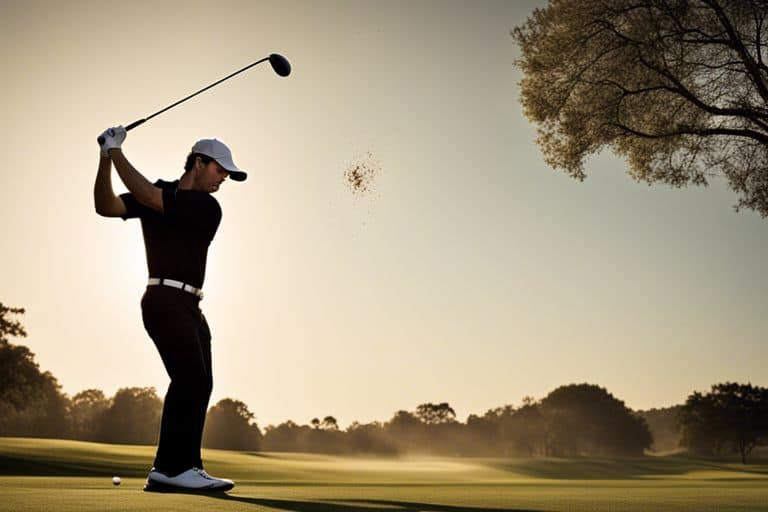What does it mean to "duff and run" a shot in golf?
Permit me to enlighten you on the meaning of the term “duff and run” in the context of golf. This term refers to a shot where the golfer makes poor contact with the ball, causing it to travel a short distance along the ground. The danger with this type of shot is that it can result in a loss of distance and accuracy. However, with proper technique and practice, you can learn to make the most of a duff and run shot and potentially improve your game. I will discuss the nuances of this shot and provide tips for executing it effectively in this blog post.
The Definition of “Duff and Run”
To duff and run a shot in golf refers to a specific type of shot execution that involves hitting the ball poorly, resulting in a low-flying trajectory and a subsequent roll on the ground towards the target. This technique is often used when the golfer is faced with a challenging lie, such as in thick rough or a tight lie around the green. Understanding the nuances of the duff and run shot can be beneficial for golfers of all skill levels, as it can be a valuable tool in navigating the diverse terrain of a golf course.
What is a “Duff” in Golf?
The term “duff” in golf is colloquially used to describe a poorly executed shot where the club head makes inadequate contact with the ball, resulting in a weak and erratic trajectory. This can happen for a variety of reasons, including mishitting the ball, taking too much turf before making contact, or simply misjudging the shot. When a duff occurs, you may see the ball travel only a short distance and stay relatively close to the ground, making it a challenging outcome to recover from.
The “Run” Aspect of the Shot
On the other hand, the “run” aspect of the duff and run shot refers to the subsequent roll of the ball on the ground after the initial impact. Due to the low trajectory of the duff, the ball is more likely to stay in contact with the ground for a longer period of time, leading to a more predictable and controlled roll towards the target. This can be advantageous in certain situations where getting the ball close to the hole is the primary objective, as the ground roll allows for a smoother and more reliable outcome.
I hope this helps! Let me know if you need anything else!

Common Causes of a “Duff and Run”
Some of the most common causes of a “duff and run” shot in golf include technical mistakes in swing and course conditions that can impact the ball’s trajectory. Identifying these causes can help you improve your game and avoid these frustrating shots.
Technical Mistakes in Swing
One of the main reasons for a “duff and run” shot is making technical mistakes in your swing. This can include decelerating through impact, hitting the ground before the ball, or failing to make solid contact. These mistakes can result in a loss of power and accuracy, leading to the ball rolling along the ground instead of flying through the air as intended.
Course Conditions and Their Impact
Course conditions also play a significant role in causing a “duff and run” shot. Wet or uneven ground, thick rough, or unpredictable wind can all affect the outcome of your shot. For example, hitting from thick rough can cause the club to get caught in the grass, resulting in a duffed shot. Additionally, playing in strong wind can influence the ball’s flight path and make it difficult to execute a clean shot.

Strategies to Avoid “Duff and Run”
However, there are several strategies I use to avoid duff and run shots and improve my overall golf game. One of the most important aspects of avoiding duff and run shots is to ensure proper swing technique and make adjustments based on different course conditions. By mastering these strategies, you can significantly reduce the occurrence of duff and run shots and lower your golf scores.
Improving Swing Technique
Improving your swing technique is key to avoiding duff and run shots. One common mistake that leads to duff and run shots is not making solid contact with the ball. To improve your swing technique, focus on maintaining a steady lower body and generating power from your core and upper body. Additionally, practice proper weight transfer and follow through to ensure clean contact with the ball.
Adjustments for Different Course Conditions
Another important strategy to avoid duff and run shots is to make adjustments based on different course conditions. If you are playing on a wet or soggy course, I suggest using a higher lofted club to help the ball get airborne and avoid the duff and run scenario. On the other hand, when playing on a dry and firm course, you may need to adjust your club selection and aim to hit the ball low to avoid the duff and run outcome.
Mastering the Recovery from a “Duff and Run”
After a duff and run shot in golf, it’s essential to focus on recovering effectively to salvage your score. I have found that mastering the recovery from a duff and run can make a significant difference in your overall game. Here are some key strategies to help you regain control and confidence after a disappointing shot.
Mental Approach and Confidence
When facing a duff and run situation, it’s crucial to maintain a positive mental approach and confidence in your abilities. Remind yourself that every golfer, even professionals, have off moments. Visualize your next shot being successful and focus on the fundamentals of your swing. Take a deep breath, clear your mind, and approach the next shot with confidence. Remember, mindset plays a crucial role in golf, and maintaining a positive outlook after a duff and run can help you bounce back effectively.
Practical Tips for the Next Shot
Here are some practical tips to help you recover from a duff and run and set yourself up for a successful next shot:
- Assess the lie of the ball: Take a close look at the lie of the ball after your duff and run. This will help you determine the type of shot to play next.
- Choose the right club: Depending on the distance to the hole and the lie of the ball, select the appropriate club for your next shot.
- Focus on clean contact: When setting up for your next shot, prioritize making clean contact with the ball. This will help you avoid another duff and run situation.
Knowing how to approach the next shot with the right mindset and practical tips can help you recover effectively from a duff and run in golf and set yourself up for success on the course.

Conclusion
Considering all points, it is clear that to “duff and run” a shot in golf means to mishit the ball and have it travel a short distance along the ground, rather than hitting it cleanly through the air. This technique can be useful in certain situations on the course, such as when you need to get the ball out of a tight spot and onto the green. However, it requires precise execution and control, as it can be a risky move. Understanding the concept and practice of “duff and run” shots can be a valuable skill for any golfer looking to improve their game.






